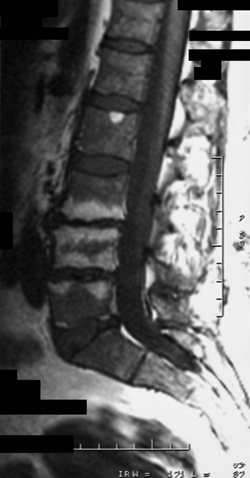47 A 44-year-old woman presented with chronic mechanical low back pain and antalgic weakness of the hip flexors. She has an obese habitus and is a heavy smoker. T1-weighted magnetic resonance imaging (MRI) of the lumbar spine shows degenerative changes at L3-L4 and L4-L5, with decreased disc space height, anterior osteo-phytes, and Modic end-plate changes indicating anterior column instability. There is multilevel lumbar facet hypertrophy as well (Fig. 47-1). Lumbar instability This patient had bilateral L3-L4, L4-L5 laminectomies and posterior lumbar interbody fusions, with an L3-S1 pedicle screw fixation. The presence of Modic end-plate changes indicates anterior column instability, which typically presents with severe mechanical back pain. Following interbody fusion, with more normal restoration of disc height, mechanical back pain improves significantly when compared with posterolateral fusion alone.
Multilevel Posterior Lumbar Interbody Fusion
Presentation
Radiologic Findings
Diagnosis
Treatment
Discussion

Multilevel Posterior Lumbar Interbody Fusion
Only gold members can continue reading. Log In or Register to continue

Full access? Get Clinical Tree








